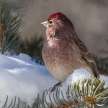
The bunting lazuli (Passerina amoena) is a North American songbird that is named as the gemstone lapis lazuli. The male is readily identifiable thanks to its bright blue head and back (lighter than the closely related indigo bunting), its conspicuous white wingbars and its light rusty breast and white ventre. The pattern of colour may suggest the eastern and western bluebirds, but the smaller size, wingbars, and short, conical bunting bill make it easy to discern. The female is black, grayer above and warmer below, seen from the indigo female bunting by two small and light wingbars and other plumage details. The music is a noisy, quick, strident warble, similar to the bunting indigo album, but longer and with less repetition. Lazuli buntings primarily stretch from southern Canada to northern Texas, central New Mexico and Arizona, and southern California, west of the 100th meridian. The breeding range extends south as the northwest of Baja California on the Pacific coast. They travel to southeastern Arizona and Mexico. Its habitat is brushy fields and sometimes weedy pastures, typically well-watered and sometimes urban. Those birds feed mainly insects and nuts. They will easily feed on the ground or in trees, but male sounds are still very obscure in the treetops. This bird makes a nest of loose herbs and rootlets contained in a field. This lays three or four bright blue eggs. It also hybridises in the eastern and southern parts of its range with indigo bunting. The male Lazuli Bunting illuminates all over the South dry brushy hillsides, thickets, and parks, flicking the blue of a gemstone lapis mixed with orange splashes. He belts his squeaky, jumbling song from the top shrubs in defence of his turf. The brightly coloured female sometimes teetering on tiny stems nearby in a balancing act to touch seeds and other foods. This stocky finchlike bird is related to cardinals and grosbeaks, and frequently visits bird feeders, particularly those filled with white proso millet. Most animals mould their feathers either on the breeding grounds or wintering grounds but not on the Bunting Lazuli. After formation, they tend to moult some feathers, but then migrate to southwest U.S. and northwestern Mexico, where insects thrive during moonsoon rains. We wind up cutting their feathers in these "moulting hotspots" before setting for further south for the winter. We know people by their words, and Lazuli Buntings should do the same. When young males mimic older, nearby males, they create a kind of "pop culture" where songs from a similar region sound familiar. Males learning to understand and embrace each other from the same culture. We respond with greater vigour to international songs coming from beyond their location. The beauty of the Lazuli Bunting did not flee from the early naturalist who called it Passerina amoena, meaning lovely sparrow. Each male Lazuli Bunting chants a different combination of sounds just as we each have our own voice. Yearling males usually arrive at the breeding grounds without a song of their own. They create their own song shortly after they arrive by rearranging syllables and combining sections of many male songs. The record they created for survival is theirs. The oldest recorded Lazuli Bunting was a boy and at least 9 years old, 1 month old during Idaho banding operations when he was rescued and re-released in 1990. He'd been banded in the same area in 1981. Male sings nesting territory in solidarity. They will defend territories against each other where buntings overlap in range between Lazuli and Indigo. Nests are placed in shrubs, vines or low trees, generally 2-4 ' over the ground, closely attached to the forked branch or vertical stems.
About the Creator
MB
I am a bird aficionado and really enjoy spotting them them on hikes. I greatly appreciate the variety of birds cross North America and the world. They are amazing and intelligent creatures, each so unique and with a wonderful life.






Comments
There are no comments for this story
Be the first to respond and start the conversation.